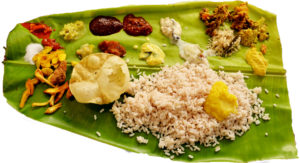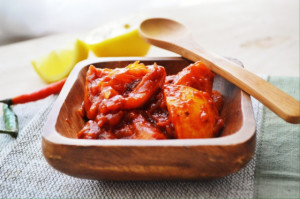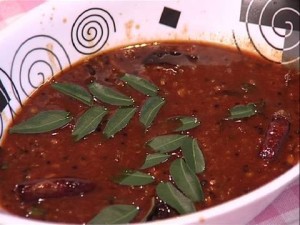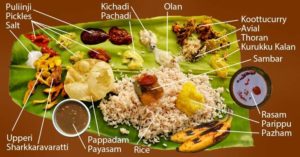Sadhya Types -Four Curry-Eight Curry-How to serve sadhya ?
Sadhya Types -Four Curry (Nalu Kootan) Eight Curry (Ettu Kootan)
Sadhya – Onam (August/September) is the pre-eminent festival in Kerala.The Onam festival celebrates the annual return of Mahabali. At the core of the festival is the Onam Sadya in which the unseen guest of honour is Mahabali. The primacy of this sadya can be gauged from an old Malayalam saying which advocates even the selling of a mortgaged land in order to eat the Onam sadya! And all other sadya are but variations of this one.
There are minor variations in the content and serving of the sadya between regions, and what is given below is specific to central Kerala. Though there are intra-regional variations, the set mode in a region is treated as sacrosanct. Within the sadya there are two primary classifications—the nalukootan sadya and ettukootan.
Read more – Onam Pookkalam – Traditional way of making Atha pookalam
The Four Curry (Nalu Kootan) refers to a sadya with four kari. Eight Curry (Ettu Kootan) sady is one where eight kari are served. The four kari are istoo,avial,erisseri and kalan. The remaining four, make up the eight are olan, pachadi, kichadi and kootukari. Some of these can be paired in terms of taste. Thus istoo and olan have much in common, and so do erisseri and kootucurry and pachadi and kichadi. Avial and are the exceptions. All these are thottukootan kari. The gravy to mix with the rice is provided by an ozhichhukootan curry like sambar or pulisseri.
How to serve Sadhya ? The sadya is always served on a banana leaf
The sadya is always served on a banana leaf, and the movie of serving follows critically important rules. Apart from rice, sambar and pulisseri all the other dishes are placed on the leaf before the guests are seated and they leave a fixed place on the leaf, any deviation from which invites rather rude comments. The spine of the banana leaf is taken as the central dividing line. The narrow end of the leaf is on the guest’s left.
Sadhya Pickles and chutneys – placed on the extreme left below the dividing line
Pickles and chutneys are placed on the extreme left below the dividing line. Two chutneys and two pickles are served at a full-course sadya. The chutneys are pulinji and injithairu and the pickles comprise chethumanga kari and a lime pickle. These four pickles are rarely ever served except at a sadya. One reason why they are included is that the sweet-sour pulinji, the chilli-ginger-curd flavoured injithairu and the spicy hot-sour lime and mango pickles complement each other and the other dishes rather well. The other is that these easy-to-make pickles and chutneys allow the cooks to spend their time, energy and skills on preparing the more complicated dishes. The third reason, could be that the dark brown pulinji, the white injithairu and the red lime and mango pickles present an inviting sight on a green banana leaf!
Above the pickles and chutneys on the other side of the dividing line, pappadum, plantain chips (two savoury and one sweet), savoury elephant foot yam chips and a ripe banana are placed. The banana is generally the short, sweet kadalipazham. If this is not in season then ripe plantains steamed in their skins and cut into five to six centimetre pieces are served.
Pappadum are of two types differentiated by their circumference and weight. While the smaller type is always available, shops stock the larger ones only during Onam. During the rest of the year (for instance, for a wedding feast) they have to be specially ordered. The pappadum are always placed over the chips without covering them entirely.
All the kari are served above the dividing line. The first is istoo. This is placed at least seven centimetres to the right of the pappadum, chips and banana. After istoo comes olan, pachadi, kichadi, avial, erisseri, kootukari and kalan. They are placed in a row with a little space between each, except for the kalan, which is placed three centimetres or so below them. This is to prevent the sweet-sour kalan from mixing with the other kari and killing their taste.
Below the dividing line and on the extreme right, salt and a pigeon pea dish (cooked with ghee and salt) is placed. While the order remains the same for a four-kari sadya, some of the kari indicated earlier, plus two chutneys, one pickle, large pappadum, ripe banana and two salty chips are generally dropped. The rice is served after the guests are seated. The serving utensil for rice is woven out of split bamboo and is cylindrical. The rice is served by jerking the basket in a smooth motion. No ladles or spoons are used.
Buy Online Pickles,Kondattoms,Pappads,Paysam ingredients from natureloc.com
























